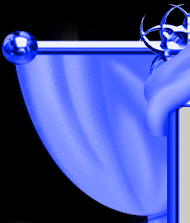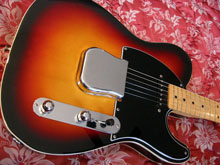 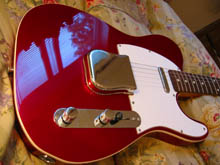 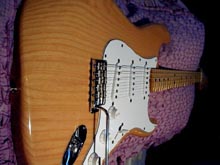 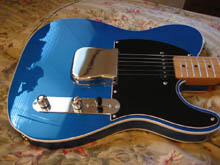  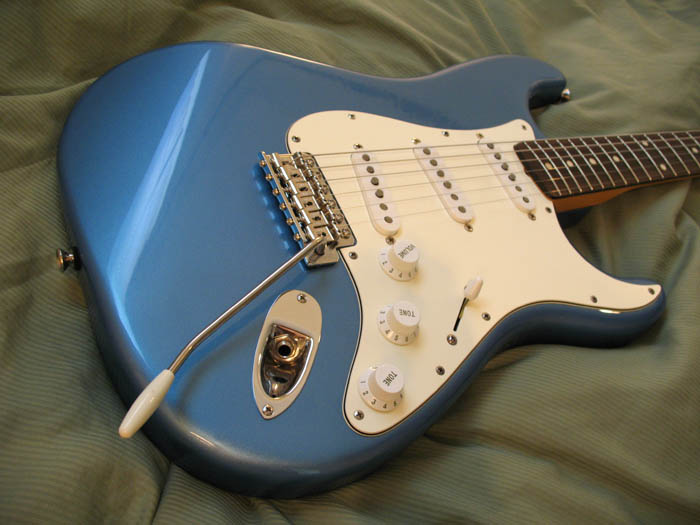 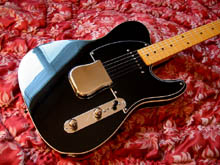
Fender MIJ and CIJ Strat & Tele Reissues
The MIJ (Made in Japan) and CIJ (Crafted in Japan) guitars are very high quality. The Japanese are, as many of you know, masters at copying—as these guitars testify. In fact, the new Fender USA management guys "almost cried" when they traveled to Japan and saw the quality. At that time, Fender USA was still trying to get back up on its feet after the CBS buyout, as USA quality under CBS ownership let their standards really slip.
Here is what happened: In 1984 CBS decided to sell Fender and finally, an investment group led by William (Bill) Schultz bought it in the month of March for twelve and a half million dollars. This investment group formally became the Fender Musical Instruments Corporation or FMIC. Bad news though, the sale did not include production facilities in Fullerton, California. Thus USA guitar production ceased between late 1984 till October of 1985 until the new factory was built in Corona, California. It has been estimated that 80% of the guitars sold during this time were made in Japan. When the Corona plant was started up, only the Vintage Reissue Stratocaster models were first produced (between late 1985 through 1986). Oddly enough, most of the MIJ Fenders were Reissues too, both Strats and Teles, and then later even Signature models.
The accuracy of these Reissues is amazing. As you can tell by these pictures of these 62RI Foto Flame Strats, (Tobbacco Burst upper, left, and the other a rare natural Blonde Tiger Striped, upper, center) every detail was reproduced, right down to “Fender” being written on the Bridge Saddles to the routing in the bodies and the slotted vintage Kluson style tuners. Even the Fender logo is the correct for this year. Once again, the Japanese detailing is amazing. Even the routing on the Tele bodies is accurate. You will consistently find this accuracy and quality with all the Reissue and Signature model MIJ and CIJ guitars, unless someone has altered them. Also, these guitars play only as good as they have been set-up. Nearly everyone, but not all, that I have bought needed to be completey re-setup.
In most cases the neck pockets and the necks it will tell you that it is the 62 Deluxe; TL-62DT = Telecaster 62 Deluxe, as with this body (above) or ST-62DT = Stratocaster 62 Deluxe as with this neck (above). The neck pockets should tell you if it is a 52RI, 68RI or 69RI, etc. The red Tele is a 62 Custom Reissue with a Bound body = TL62B =Tele 62 Bound.
I have owned, and still own, many of both the MIJ and CIJ guitars and when setup correctly and rewired, they can play, feel, and sound as good (if not in many cases, even better) than their USA counter-parts (especially when rewired with custom pickups!) This is why they often bring such a good price on various markets. If you want to know about the dates and serial numbering of MIJ and CIJ guitars CLICK HERE and go to the bottom of the page! On this page you will get a sample of a few Reissue and Signature models.
Among the Fender Japanese guitars, there were two different logos used: Crafted in Japan and Made in Japan, and both were being made at the same time from 1994 till 1997. This means that the the serial numbers starting in 1994 ran consecutively on both the MIJ and the CIJ models while the MIJ logo was being phased out. Mid–1997 the CIJ logo was the only one used on Fender guitars coming out of Japan (with exception the Squire series).
There are several theories about why some Japanese Fenders have MIJ and others CIJ. One is that there was a reorganizing of where the parts were being make in the large, expansive Fugi Gen Gakki company. The island of Matsumoto is where the Fugi plant is located. It houses 15-20 different smaller companies, Like Kawi, Gen Gakki Ten, Yamara, Gotoh, Yamoto, etc. I was told by a former Fender Rep that the necks were made one place and the bodies another, while the electronics were made in yet another. I was told that the contract with Yamoto stated if any major subcontractor was to be changed the weaning process would have to take place (MIJ to CIJ). They call it the “Squire countdown.” Since Fuji was pressing hard to get the Epiphone contract, a change was made. Kawi was moving the bulk of their piano building to a new facility in China, and would also be making their own “harp” frames there. This freed up a lot of space in the plant. Yamara and Gotoh retooled to handle the woodwork and finish aspects of the guitars—thus the Crafted in Japan line was created.
The other story is, and maybe both are true and run consecutively, I really don’t know, but the MIJ logo Fenders were for the USA market. USA Fender wanted to stop the import of these guitars to the USA due to firing up their Mexican plant and due to the “too good” quality Japan was creating which competed with the USA models.
Regarding quailty, I have owned many of both these Japanese guitars and it is a fallacy that the Made in Japan models are better than the Crafted in Japan or vice versa. As far as I am concerned, the quality of either is much better than the Mexican made guitars and rival many of the USA models. The JV and SQ guitars, as well as some of the E series, had USA parts (mostly pickups, switches, and potentiometers) that were shipped over to Japan to help speed up production while the new USA plant was being set up in Corona, California. The early series are the most popular for collectors. Also, both Made in Japan and Crafted in Japan models came as Custom Shop models, "Custom Edition" (EXTRAD) as well as, special "Limited Edition" and Signature guitars.
The Japanese serial number can be confusing too. For instance, many of the MIJ/CIJ Telecasters have the serial number on the bridge and they start with an "A". Yet if you take the neck off they can be 1994-1997!
There has been some questions about the MIJ EXTRAD guitars. The Extrad is a Japanese "Custom Edition" guitar, which is just under the Japanese Custom Shop models. They are dead on replicas of the original vintage Fenders, shot with 100% nitro and often use USA electronics. They made 52 Teles, some very nice Strats, some even with Lace Sensor pickups. The quality is better than Fender USA excluding the USA Custom Shop models.They were made in Japan too, so do not think they were made in USA and shipped to Japan. Just read the history (above) of Fender Japan and that is easy to understand!
You can tell if you have an EXTRAD. They will have "EXTRAD — Custom Made" written on the back of the headstock or by the serial number. On some guitars there is found an "EX" on the part numbers located on the neck socket of the body or the heal of the neck. This DOES NOT mean you have an EXTRAD but simply that you have a guitar that was meant to be EXPORTED! (See above) any of the mid-1980s models will also have FENDER stamped on the neck plate.
To see more of the Reissue Strats and Teles, CLICK HERE to go to the Foto-Flame page, as most of those were also Reissue guitars.
First, let's look at some of the Jerry Donahue Signature Model Telecasters:
Customized Jerry Donahue Signature Model Telecasters
When Jerry Donahue, the famous “string bender” of the group “Hellcasters,” wanted a custom Telecaster that could give him the best of both worlds for touring and to meet his demanding playing style, he turned to Fender’s Custom Shop. Together, they designed a Telecaster that has a vintage 52 bridge and pickup with a true 52 Tele V shaped neck. They took a 62 Tele bound body, plus the added touch of a vintage Stratocaster sound with a Strat Pickup in the neck position, along with the extra touch of the famous "out-of-phase" Strat sound by using some tricky custom wiring—thus you have a JD Tele! Kind of a Strat-o-tele! Fender’s Custom Shop started manufacturing the Jerry Donahue Custom Shop Tele (some going at a pricy $3,200!). Later the Fender’s CIJ factory came out with a Jerry Donahue Signature Model. Some of these varied, as did the rival US Custom Shop models. The JD Teles came in 4 colors: transparent sunburst, red, blue and solid black all double-bound editions.
The stock JD had interesting 5-way switching. All the guitars below have my modified 5-way switching, but I wanted to explain the stock version before going on to the customized versions.
Here is how the STOCK switching works: Position 1) The Bridge PU give Jerry’s favorite customized 1952 vintage sound. Position 2) The Bridge PU and the Neck PU out-of-phase. This gives that unique Strat sound, as it puts a Tele PU and the Vintage Strat PU in an out-of-phase mode. Really cool JD trick. Position 3) The Bridge PU and the Neck PU in parallel, like a stock Tele in the middle switch position, creating a sweet full rhythm sound. Position 4) The Neck pickup going through the tone control. Position 5) The Neck PU by-passing the tone control.
PLEASE NOTE! MOST OF THE JD TELES HAVE BEEN MODIFIED WITH NEWER WIRING AND CUSTOM PICKUPS!
This is a Transparent SUNBURST, with ivory white double binding, 1998 Fender CIJ Jerry Donahue Signature Model Telecaster. (Serial #A014478). I gutted this one and replaced everything with high-end USA parts, yet retained the JD wiring features, plus some!
The NECK pickup is a SEYMOUR DUNCAN 57 VINTAGE STAGGERED (SSL-1) which is an exact replica of the original Alnico V Stratocaster pickups used in the 57 Strats. It has the same type of magnet wire that was used, and the same number of coil windings.
The BRIDGE pickup is a FENDER CUSTOM SHOP TEXAS SPECIAL. This pickup had the Custom Shop sticker on the back. It has all the chicken pick’ in bite you would expect a Tele to have, plus some Texas growl when you crank it up.
This JD Teles come custom wired from the factory with a 5-way switch. I gutted this one and replaced everything with high-end USA parts, yet retained the JD wiring features, plus some! The JD feature I liked, was the bypassing of the tone control in position #5, but it seem kind of like a waste of a switching position. So I put in a Fender “No-load” tone control so one can still have this “by-pass” feature, but now on both the neck and bridge pickups. This way you get full screaming power of the pickups with no resistance! Position #5 is now replaced with Fender’s series wiring for that “fat” sound.
Here is how the modified switching works: Position 1) The Bridge PU give Jerry’s favorite customized 1952 vintage sound. Position 2) The Bridge PU and the Neck PU out-of-phase. This gives that unique Strat sound, as it puts a Tele PU and the Vintage Strat PU in an out-of-phase mode. Really cool JD trick. Position 3) The Bridge PU and the Neck PU in parallel, creating a sweet full rhythm sound. Position 4) The Neck and Bridge pickups wired in series, which is like creating one large spread-out humbucker! Great for a fat, full, Gibson-ish sound. Position 5) The Neck PU that gives a true-to-life vintage Strat sound. Remember at any time you can totally bypass the tone control by simply turning it wide open. I replace the stock wiring on ALL my JD Teles to this better modified version.
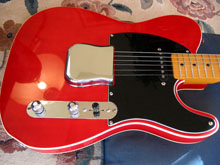 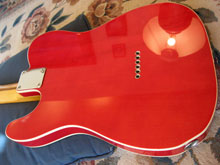 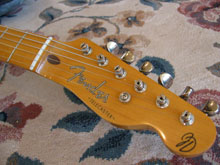
This is another CIJ Fender Jerry Donahue Signature Model Telecaster made in 1997, but this time in a transparent red color. Like the Sunburst one above, it features wiring, plus a few other modification such as beening upgraded with USA Fender slotted Kluson LOCKING Tuners. Pull the string through the hole, tighten and then cut off all excess. Fast, easy, yet still retains that vintage look.
 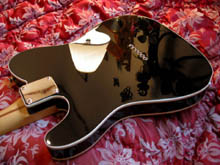 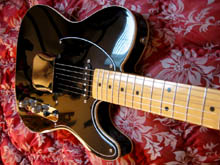
This is a black, with ivory white double binding, 1996 Anniversary Fender MIJ Jerry Donahue Signature Model Telecaster. (Serial #A055016) It is wired with the modified wiring ljust ike the Red JD Tele above, but with a different bridge pickup. The NECK pickup is a Seymour Duncan SSL-1 which is an exact replica of the original Alnico V Stratocaster pickup used in the 57 Strats. The BRIDGE pickup is a Seymour Duncan (APTL-1) Alnico II Pro. The Alnico Pro pickups were designed to give a a warmer, sweeter tone. The magnets, as Seymour Duncan states, are the musical magnets. Their softer magnetic field provides and eliminates the brittle, glassy sound associated with many of the newer instruments. The result is a freer, more natural string vibration for greater sustain and has really nice tone and performance. The result is a traditional, sweet and even tone that just drips with all the sparkle and twang you'd expect out of a vintage sounding Tele bridge.
This is a very fine example of CIJ workmanship. It is a 1997 transparent blue, with ivory white double binding, Jerry Donahue Signature Model Telecaster. This Tele has had a specially selected pickup upgrade to enhance the tone. When you think of this JD Tele, think vintage sound! 52 Tele bridge pickup - 57 Strat neck pickup! The JD Teles are no longer made.
The JD Teles have a skunk-striped solid Maple, and has that true 1952 deep V shape design, with vintage Kluson tuners. This one toto, has had the stock JD wiring replaced with my modified verison of the the same as mention already above.
This one also has in the NECK a Seymour Duncan SSL-1 which is an exact replica of the original Alnico V Stratocaster pickups used in the 57 Strats. It has the same type of magnet wire that was used, and the same number of coil windings. The staggered rod magnets are hand-ground, then aged by the Seymour Duncan’s exclusive Dun-Aged process. They even have lacquered bobbins and cloth-braid hookup wires. The vintage look and vintage sound! Every detail is included to duplicate the bell-like tone that made the vintage Strats famous.
The BRIDGE pickup is a Fender 50’s Telecaster Custom Shop pickup. This Telecaster pickup comes from Fender’s Custom Shop and is manufactured exactly like the 1950s Telecaster bridge pickup. Unprecedented edgy sound and great sustain that make Telecasters famous. It has all the bright crispness and bite of the old traditional 52 Tele. It was my desire to have this sound be as much of a 1952 Tele as possible, thus the reason this pickup was chosen. Like most of the Teles I customize, Calibrated Brass Saddles, which were developed for Danny Gatton’s Tele, keep the intonation more accurate than the old stock fender saddles.
Other MIJ/CIJ Reissue Guitars!
This is another fine example are Japanese workmanship—a 1998 FENDER CIJ TELECASTER 1962 REISSUE in red. Every detail reflects a 62 telecaster, with white ivory double binding, vintage bridge with “Ashtray,” white 3-ply pickguard, and a slim, Rosewood on Maple neck. This guitar is like new and plays like a 62 should—fast, with a lot of twange. You can see the similarities between this 62RI and the Jerry Donahue Signature Tele. This one is completely stock. Wonderful guitar that will stand side by side with any USA model.
Speaking of 62 Tele Reissues, here is a nice example of a 1999 Fender CIJ 62 Custom Telecaster Reissue with white ivory double binding on a BLACK body and a matching black pickguard. The guitar is mint and is a prefect reproduction of the original 1962 Telecaster, EXCEPT for my custom modifications. The NECK PICKUP is a Seymour Duncan STR-1 Vintage '54 Rhythm. True vintage Telecaster rhythm tone, with all those sweet voices you would expect from a Telecaster. Seymour Duncan take great care in making these pickups to the exact specifications of the old 1954 pickups, right down to the cloth wiring and magnets.
The BRIDGE PICKUP is a Fender Texas Special, which gives you some hot Texas spank and growl. Nice for everything from county to blues. I love’em.
JERRY DONAHUE MODIFIED TRICK WIRING: there are a lot of people emailing me off my website asking for the wiring diagram on how I do this, but so far I have not given it out. It is a modified version of the Jerry Donahue Telecaster 5-way switching. This gives you the 3 true vintage Telecaster voices, plus a Stratocaster out-of-phase and a humbucker type voices.
 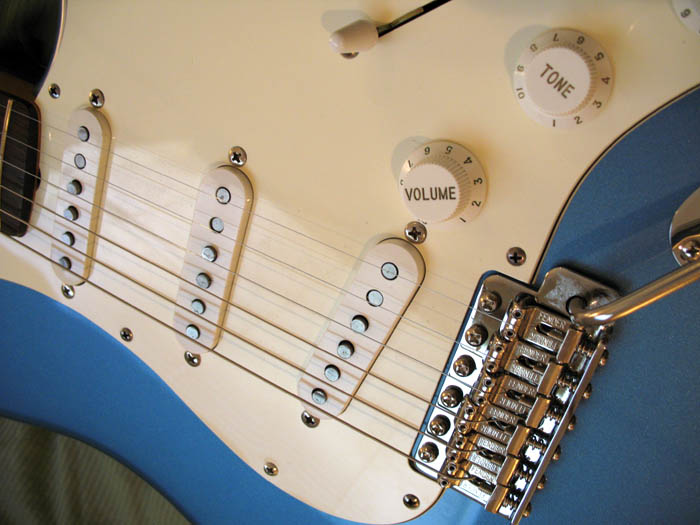 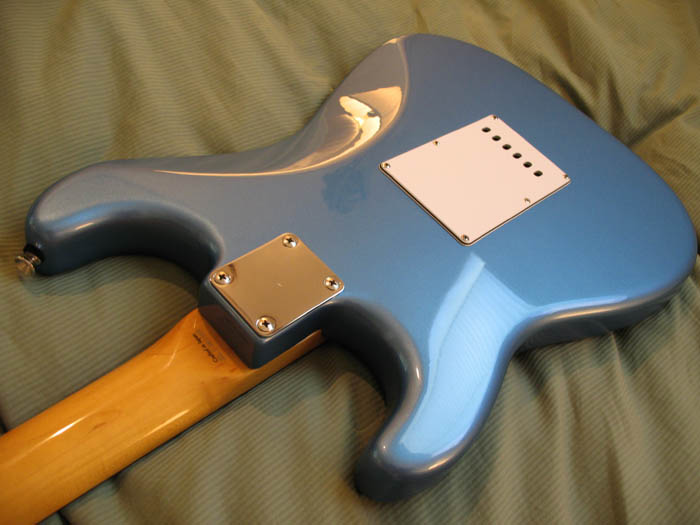
This is a Fender CIJ 2005 LAKE PLACID BLUE 1962 STRATOCASTER REISSUE that has been completely rewired using all new USA parts and Fender Custom Shop pickups. (Serial #S065588). I picked this up some time back, custom wired it, played it like 3 or 4 times and tucked it away in my collection. It still has all the original case candy!
When I rewired this guitar, I started out with a new set of Fender Custom Shop Texas Special pickups. I guess I had Stevie Ray Vaughn in mind. Since this is a 1962 Reissue, all the wiring has been re-done with vintage cloth wire. It has an old ceramic style capacitor on both tone controls. The second tone control is a Fender No-Load tone control. Turn it to 10 and you bypass the tone control completely, thus giving you the middle pickup with no resistance. If you want to see how this was wired, go to my Custom Wiring page.
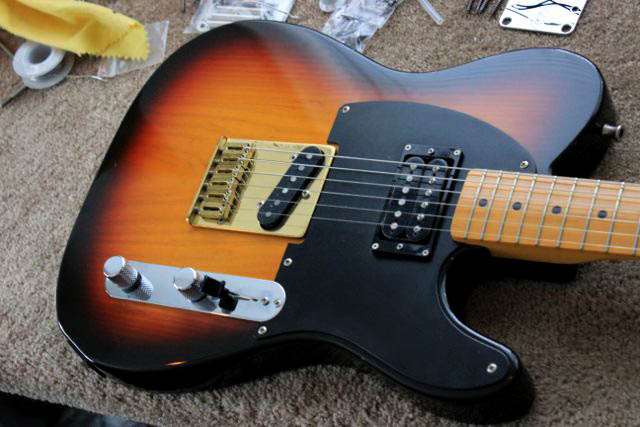 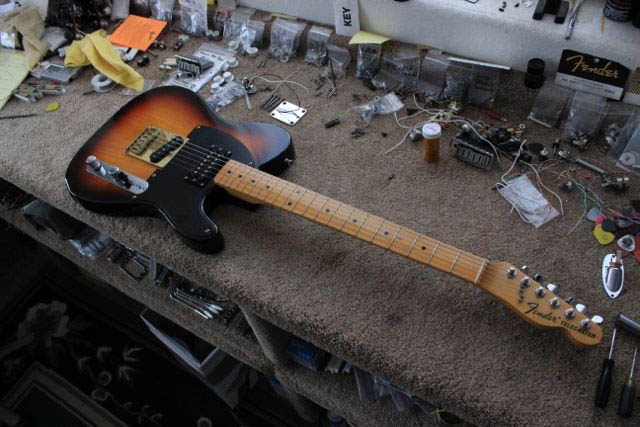
This is a STOCK FENDER CIJ SUNBURST 1967 "Keith Richard's Sonny" REISSUE TELECASTER. (above) Now this is a Telecaster I love. It is called the the TL67-65SPL by Fender Japan, and is a Keith Richards “Sonny” replica reissue. Most of the time when people talk about Keith Richards Telecasters they think of his Blonde 1953 Fender Telecaster nicknamed “Micawber.” But there was yet another famous Keith Tele that does not get talked about much. Perhaps it is because Fender USA never made a reissue of this model— it is “Sonny” which is a 1967 Sunburst Telecaster (below right).
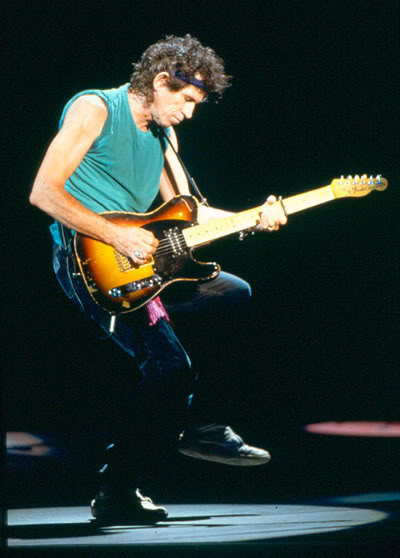 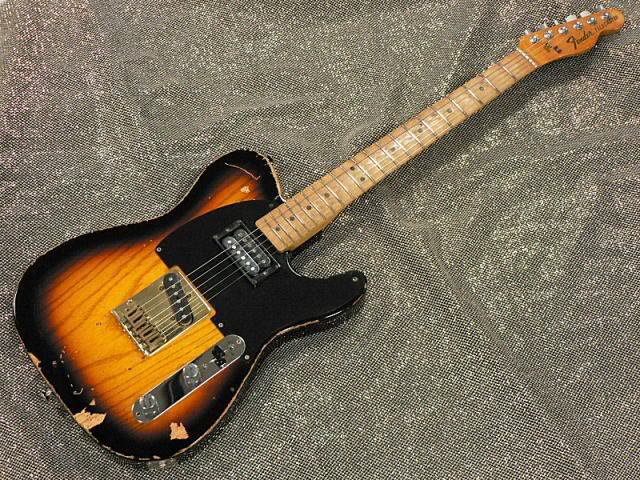
Fender Japan did make a reissue of the “Sonny” Tele minus the relic looks and the fact it has 6 strings instead of 5! They were never imported to the USA. I rarely see these and almost every time I do, I buy them. Very hard to find and one of the best Telecasters ever (I have owned 5 of these.) When you think of this guitar, think a 52RI Custom with a 67 C style neck! They come with a heavy chunk of Asian Ash (Sen) for a body in sunburst (Sonny come from sun burst) with a nice 67 type Maple D-shape neck (324mm Scale, (7.5") radius Fretboard, 21 Vintage frets, 42mm nut width) equipped with Chrome Gotoh Tuners. They also come equipped with a BRASS bridge and saddles. Andy Summers uses the same kind of bridge on his Telecaster as well. BTW, I have never seen a USA version of this guitar. This particular model was never imported into the US from Japan. Every one I have bought either was shipped from Japan or was brought over by some one, thus making this model rarer in the US. They come stock with a 3-way switch, a vintage Tele bridge pickup (same pickup Fender Japan uses on their 62 reissues) and a Fender Atomic him bucker in the neck.
 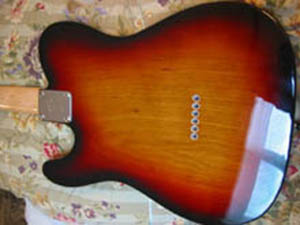 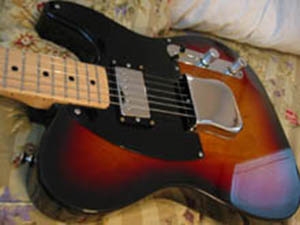
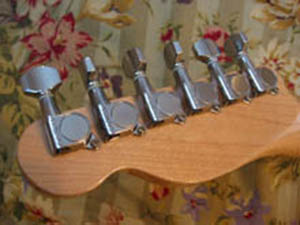 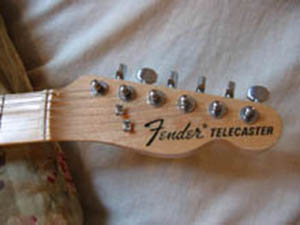 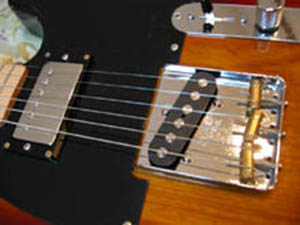
BUT, as soon as I get one of these, I custom wire them with a fender 5-way Super switch and sometimes I replace the bridge with a vintage 67 style, often with calibrated brass saddles. I just like the looks and the chrome ashtray cover. The one below is a 1994 model. This one was completely rewired using high-end USA parts. As mentioned already, this particular model was never imported into the US and was bought brand new by a gentlemen who was serving in Japan in the military in the early 1990’s. This guitar has wonderful sustain, as it is heavy as a Les Paul. The pickguard is one piece black and is 5 hole like a 52 Tele. The neck is made from a beautiful solid Maple, with a Maple capped fret board. The radius is like the vintage 62/67 style—a soft, slim, C shape.
The one above is a FENDER CIJ SUNBURST 1967 CUSTOM SONNY REISSUE TELECASTER. (Production: 1994, Serial #O 003418). this one was completely rewired using high-end USA parts. As mentioned already, this particular model was never imported into the US and was bought brand new by a gentlemen who was serving in Japan in the military in the early 1990’s. This guitar has wonderful sustain, as it is heavy as a Les Paul. The pickguard is one piece black and is 5 hole like a 52 Tele. The neck is made from a beautiful solid Maple, with a Maple capped fret board. The radius is like the vintage 62/67 style—a soft, slim, C shape. They come with chrome plated Gotoh Tuners. This utilizes the Fender USA 5-way Super switch, which I will explain in a few moments. As already stated, all electronic parts are brand new made in the USA.
The NECK pickup is a NOS (New Old Stock) CHROME DIMARZIO “AIR NORTON” PAF HUMBUCKER. This PU is several years old, but brand new in the unopened original box when I received it. It runs at a 12.58K DC Resistance untapped. It delivers a true vintage Gibson sound or a Tele Single coil sound, when tapped, due to the custom wiring. It's fat and warm, but not muddy. It's hot, but not distorted. It's even got cool harmonics. The Patent-Applied-For (thus PAF) magnetic structure reduces string-pull, so sustain is improved, and pick attack and dynamics are tremendously controllable and expressive.
The BRIDGE pickup is a HIGH OUTPUT SEYMOUR DUNCAN 1/4 POUNDER which run’s at a hot 17.38k D.C. Resistance, which is over 2 times hotter than a stock Tele bridge PU. This single coil pickup was specially selected so it would have enough power to compete with humbucker in the neck. The stronger magnetic field of the quarter-inch wide pole pieces increases the output along with its special coil winding which allows it to keep the high-end definition for great treble bite and a full, powerful midrange.
The custom 5-way switching really makes this Tele have the best of both worlds. You can sounds like a Gibson Les Paul or a Standard Telecaster. You can also mix and match sounds. Here is how the Fender Super Switching works: Position #1: is the Bridge PU alone, creating a traditional Tele sound with more power and a bit more midrange and bottom end. Lot’s of Tele bite! Position #2: is the Bridge PU and the Neck PU split into a single coil (tapped), creating a more tradition Tele neck/bridge sound. Position #3: is the Bridge PU together with the Neck PU operating as a full Humbucker. This creates a unique sound, which is a richer and fuller. A Gibson/Telecaster hybrid! Position #4: is the Neck Humbucker split (tapped) to create more of a sweet vintage Telecaster neck sound. Position #5: is the Neck Humbucker in all its humbucking glory—delivering a Les Paul sound. Full, rich and powerful! The tone control is wired with Fender TBX tone system. (I have owned 5 of these and customized all of them. I still have one tucked away and it is the sweetest, Les Paul type Tele I have ever owned!)
This is a Fender 1972 Telecaster Standard Reissue in a transparent Butterscotch on Ash. (CIJ 1994, Serial #O 004750). When you think of this guitar, think 52 style transparent butterscotch finish, and 69 Thinline type Maple neck. The Peavey Guitar Company in Meridian, MS bought this guitar directly from Fender Japan. I bought it from an employee that said Peavey bought to disassemble to inspect the quality, etc. It has never really been played. I took the guitar, customized it and tucked it away in my collection.
The NECK pickup is a high output Seymour Duncan (STL-2R). This pickup delivers a fat and full punch in both the low and mid-range frequencies. It uses Alnico 5 rods and special high-output coil winding for full, clear sound, running at 9.7k.
The BRIDGE pickup is a DiMarzio HS-3T (DP118). Ok. This pickup is a rare bird for a Tele. This was New Old Stock from the 1980s. I was somewhat hesitant and skeptical when I first saw this pickup. Would a pickup that was made famous by Yngwie and used in a Strat in the bridge position sound good as a Tele bridge pickup? I no sooner plugged it in I found out! Teles sometimes have too much bite. This PU still bites but creates super harmonics and sustain. The HS-3T was designed to have a broad low-end while gently rolling back the top, which resulted in a warmth without a glaring high-end; just right for the guitar that needs more body and less screech. It runs at a hot 23.72k! The smooth tone curves of the HS-3T produces a sweet over-drive tone without jagged edges. The HS-3T hum-free design lends itself to any performance situation.
Check out the 52 Reissue page ......... Soon I will have all the reissues on their own pages...when i can get some time. I have a lot more guitars that could go on this sight and history, etc!
This is a 1997 CIJ 1968 Stratocaster Reissue. (Serial #A098939) This is completely original except for the electronics. These MIJ Teles and Strats are becoming more of a collector’s item due to their high quality. This 68RI had the pickups changed to a matched set of Seymour Duncan Vintage Staggered for Strat (SSL-1). Since this is a 68 RI, I figured I wanted the best vintage sound I could get, so these pickups were chosen. They are an exact replica of the original Fender Alnico V Stratocaster pickups. The same type of magnet wire is used, as well as the same number of coil windings. The staggered rod magnets are hand-ground, then aged by the exclusive Dun-Aged process; lacquered bobbins and cloth-braid hookup wire complete the vintage look. Every detail is included to duplicate the bell-like tone and the high-end bite that made the vintage Strats famous.
This 68 Strat RI model has a beautiful natural finished split Ash body. The wood is split down the middle with such craftsmanship, that it looks like one solid piece, until you examine the end where you see the grain "fold in" toward the middle. This creates a gorgeous look. The finish is near mint and replicates the deep thick finish they used during this era of Strats. Because of the finish, the grain really stands out. Ash has outstanding grain and gives a great resonance. The pickgaurd is a White, Black, White. Even the routing on these guitars are vintage, instead of the big gaping hole route found in the newer USA Strats. The neck is Maple on Maple, 21 fret laminated fret board. It has the large headstock, like on the Hendrix signature Strats. The bridge is the vintage style with Fender written on each saddle.
MORE Coming!!!
|
